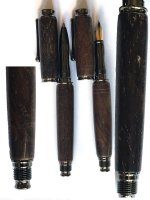Chriscb
Full Member
Evening ladies and gentlemen,
Doki oki, here I was turning some leadwood for the omega's attached and all was well. Process to get me there was pretty normal.
Drilled out to the correct diameter, very slowly and with great care. Tubes fitted well, not too tight but snug. Glued with 5 minute epoxy and began turning.
Got to the sanding stage and noticed the odd marks on the surface - pitting of some kind. Went through the sanding again and they cleared up to a degree, but were still just visible. Finished off with sealer, melamine lacquer and wax.
Then I made up the pen - not horrendous pressure applied to press home the bits. But then an audible crack when the bottom was pressed home, was followed by others resulting in the fine hairline cracks just visible in the picture. So, thinking I had use the wrong drills i prepared a second blank. I repeated the turning again, but this time didn't glue in the tubes and left them overnight in the workshop.
In the morning I found that the tubes had become very tight, and under high magnification I could see very fine hairline cracks at the open ends. Moisture reader showed 12% average across all of the leadwood blanks I have.
So, can I have some observations from the experts please. I've turned lead wood before without issue, so I have no idea what happened here. I used abranet sanding papers, going through the grades, so could that be the source of the pitting?
I haven't turned an Omega with leadwood before, and I'm using the pens as I really like the gunmetal/leadwood combination, but would like to sell them with out the cracks and pitting!
Thanks,
Chriscb
Doki oki, here I was turning some leadwood for the omega's attached and all was well. Process to get me there was pretty normal.
Drilled out to the correct diameter, very slowly and with great care. Tubes fitted well, not too tight but snug. Glued with 5 minute epoxy and began turning.
Got to the sanding stage and noticed the odd marks on the surface - pitting of some kind. Went through the sanding again and they cleared up to a degree, but were still just visible. Finished off with sealer, melamine lacquer and wax.
Then I made up the pen - not horrendous pressure applied to press home the bits. But then an audible crack when the bottom was pressed home, was followed by others resulting in the fine hairline cracks just visible in the picture. So, thinking I had use the wrong drills i prepared a second blank. I repeated the turning again, but this time didn't glue in the tubes and left them overnight in the workshop.
In the morning I found that the tubes had become very tight, and under high magnification I could see very fine hairline cracks at the open ends. Moisture reader showed 12% average across all of the leadwood blanks I have.
So, can I have some observations from the experts please. I've turned lead wood before without issue, so I have no idea what happened here. I used abranet sanding papers, going through the grades, so could that be the source of the pitting?
I haven't turned an Omega with leadwood before, and I'm using the pens as I really like the gunmetal/leadwood combination, but would like to sell them with out the cracks and pitting!
Thanks,
Chriscb


